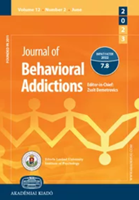A cross-national comparison of problematic gaming behavior and well-being in adolescents
A cross-national comparison of problematic gaming behavior and well-being in adolescents
Author(s): Damian Van Der Neut, Margot Peeters, Meyran Boniel-Nissim, Helena Jeriček Klanšček, Leila Oja, Regina van den EijndenSubject(s): Behaviorism, Methodology and research technology, Substance abuse and addiction, Health and medicine and law
Published by: Akadémiai Kiadó
Keywords: problematic gaming; cross-national; peer ssupport; life satisfaction; psychological complaints;
Summary/Abstract: Background and aims. The popularity of playing games among adolescents has increased during the last decades, possibly affecting the prevalence of problematic gaming behavior. The current study aimed to compare country-level prevalence rates of adolescents’ problematic gaming behavior in five countries and identify cross-cultural similarities and differences in the relationship between problematic gaming and well-being (life satisfaction, psychological complaints, and peer support). Methods. Cross-national data from the Health Behavior in School-aged Children (HBSC) study were used. The sample comprised 14,398 gamers (61% boys) aged 11 to 16 (average age between 13.31 and 13.85) from Azerbaijan, England, Serbia, Slovenia, and the Netherlands. Results. The findings showed that the prevalence of problematic gaming differs between countries. The highest prevalence of problematic gaming was seen in Azerbaijan (16.1%) and the lowest in the Netherlands (4.3%). In contrast, Azerbaijan reported the lowest gaming intensity, whereas the Netherlands and England showed the highest gaming intensity. Additional analyses revealed that problematic gaming was associated with lower life satisfaction, more psychological complaints, and lower peer support in all countries, although the strength of these associations varied between countries. Discussion and conclusions. The current study’s results are consistent with the assumption that problematic gaming negatively affects adolescents’ social and mental well-being. These findings are further discussed in light of the normalization theory which suggests that cultural gaming norms (i.e., the percentage of gamers per country) would influence the strength of the relationship between problematic gaming and adolescents’ well-being. The present findings highlight the need for adequate prevention strategies aiming at problematic gaming among youngsters.
Journal: Journal of Behavioral Addictions
- Issue Year: 12/2023
- Issue No: 2
- Page Range: 448-457
- Page Count: 10
- Language: English

